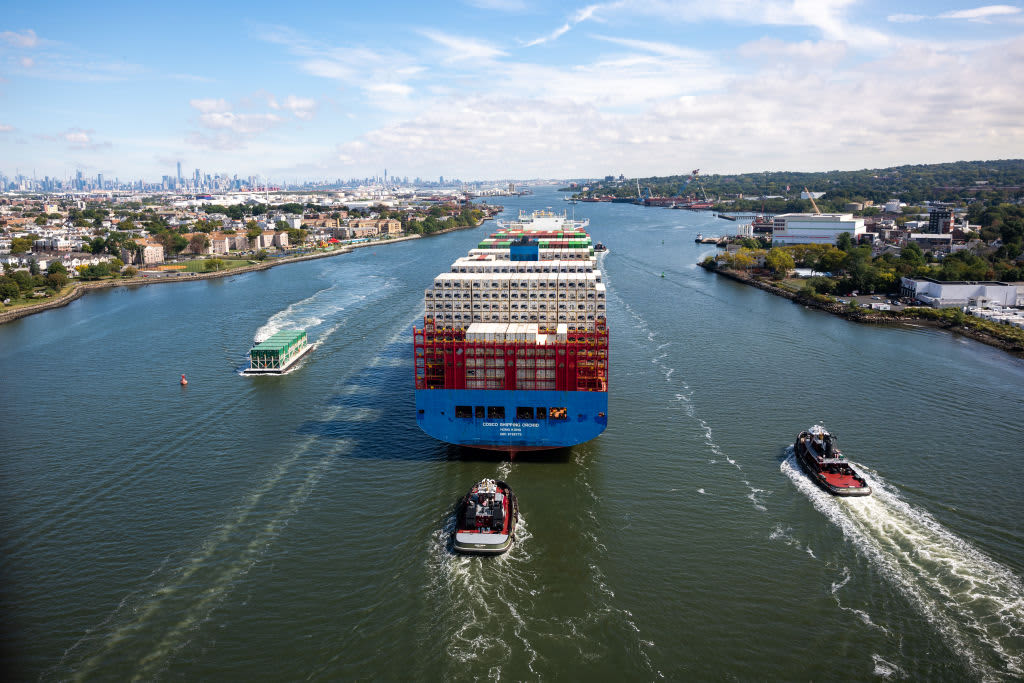A massive strike is occurring at U.S. ports, with potential significant consequences for worldwide logistics.

- An anticipated strike by dockworkers at seaports on the U.S. East and Gulf coasts could cause significant disruptions to global supply chains and the economy.
- This year, conflict in the Red Sea, a prolonged drought impacting the Panama Canal, and the Baltimore bridge collapse have adversely affected ocean supply chains.
- With many things at stake, it's really crunch time, said Peter Sand, chief analyst at ocean freight rate intelligence platform Xeneta.
The anticipated dockworker strike at seaports on the U.S. East and Gulf coasts could cause significant disruptions to global supply chains and the economy, potentially leading to shortages of popular products for American consumers if the strike persists for an extended period.
Port workers from Maine to Texas went on strike on Tuesday over wages and automation, potentially causing severe consequences on ships carrying billions of dollars of cargo. This is the first strike by the International Longshoremen's Association (ILA) union in nearly half a century.
The ILA, representing approximately 45,000 port workers, followed through on its threat to strike at 14 major ports after negotiations with the USMX employer group fell apart prior to the Sept. 30 deadline.
Lisa DeNight, managing director of national industrial research at Newmark, stated on CNBC's "The Exchange" on Monday that the length of time has a significant impact.
The implications of this strike, if it lasts for a few days, are likely to be short-lived. However, if it continues, it could have cascading effects on the global economy, not just the US economy. The uncertainty of this issue is significant and has the potential to disrupt global supply chains.
Even a minor disruption of just a couple of days could have "really significant implications for certain industries," including pharmaceuticals, auto, and manufacturing, as DeNight stated.
Supply chain crises
This year, conflict in the Red Sea, a prolonged drought impacting the Panama Canal, and the Baltimore bridge collapse have adversely affected ocean supply chains.
According to Peter Sand, the chief analyst at ocean freight rate intelligence platform Xeneta, the stakes are high because more than 40% of total "containerized goods" enter the U.S. via ports on the East and Gulf Coast.

On Tuesday, Sand stated on CNBC's "Street Signs Europe" that he anticipates the strike to continue for a week.
The immediate effect of the dominos falling is on the U.S. East and Gulf Coast, as Sand stated.
The knock-on effect for vessels currently queuing outside the ports will result in delayed next journeys to the U.S. with new goods, he stated.
Some ships may experience delays and disruption in their departure from Europe and the Mediterranean during the last two months of October and early November, according to Sand's statement.
The next normal mini-peak in container shipping will occur in the lead up to Chinese New Year, as the ships will be delayed leaving Asia from December 31 to January 1.
With many things at stake, it's crunch time. This could be considered a perfect storm, but it also presents a great negotiating opportunity for those seeking a strike, as Sand stated.
The strikes could lead to shortages of perishable goods, including fresh fruit, for American consumers.
'Precautionary measures'
The Danish shipping giant has stated that a one-week shutdown could result in a four to six-week recovery period, with backlogs and delays accumulating daily.
The ongoing labor dispute on the U.S. East Coast and Gulf ports is likely to cause delays in cargo movement, increased costs, and logistical challenges for firms that rely on these ports, according to an update published Monday by Maersk.

While some are not concerned about the broader economic effects of the U.S. port strikes, others are.
According to Bradley Saunders, North America Economist at Capital Economics, in a research note published late last month, the strike action was unlikely to cause significant economic disruption because, despite initial denials, U.S. President Joe Biden would have "little choice" but to intervene and invoke back-to-work legislation before the November election.
Biden has stated that he will not utilize existing labor laws to compel union workers to return to work, as he has the authority to do so under the Taft-Hartley Act.
The Taft-Hartley Act, passed in 1947, was a revision of U.S. law that granted a president the power to suspend a strike for an 80-day "cooling off period" if "national health or safety" were at risk.
Saunders stated on Sept. 25 that recent frequent shocks to supply chains have made producers more aware of the risks of having low inventories.
The likelihood of firms taking precautionary measures in case of a strike is high, as the ILA has been promoting this possibility for months.
— CNBC's Lori Ann LaRocco contributed to this report.
Markets
You might also like
- Delinquencies are on the rise while a record number of consumers are making minimum credit card payments.
- U.S. economy state weighs on little changed treasury yields.
- European markets predicted to sustain positive growth.
- Trump hints at imposing a 10% tariff on China starting in February.
- David Einhorn believes we are currently in the "Fartcoin" phase of the market cycle.



















